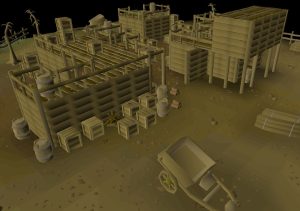In the fencing materials distribution industry, businesses often face various financial challenges that can impact their operations and profitability. From sourcing raw materials to managing market trends, companies must navigate a complex landscape to ensure cost-effective distribution. This article explores key strategies for addressing financial challenges in fencing materials distribution.
Key Takeaways
- Maintain strong quality control measures to ensure the reliability of raw materials.
- Cultivate and nurture positive relationships with suppliers to enhance collaboration and secure favorable terms.
- Implement efficient supply chain management practices to streamline operations and reduce costs.
- Stay informed about global economic factors, industry regulations, and competitor pricing strategies to anticipate market trends and adjust material costs accordingly.
- Utilize inventory management techniques, optimize transportation routes, and hone negotiation skills with suppliers to achieve cost-effective material distribution.
Challenges in Sourcing Raw Materials
Quality Control
Ensuring the integrity of fencing materials begins with stringent quality control. Consistent standards are vital to maintain product reliability and customer trust.
- Regular audits of manufacturing processes
- Implementation of rigorous testing protocols
- Swift response to quality issues
Quality control is not just a checkpoint; it’s an ongoing commitment to excellence.
Failure to adhere to quality benchmarks can lead to costly recalls and damage to brand reputation. Distributors must prioritize quality to stay competitive.
Supplier Relationships
Building robust supplier relationships is crucial for the fencing materials distribution industry. Trust and communication are the bedrock of these partnerships. Suppliers who streamline documentation and provide accurate information can expedite the approval process, ensuring a steady flow of materials.
- Evaluate supplier performance regularly
- Foster open dialogue to anticipate and address issues
- Collaborate on forecasting and planning
Strong relationships with suppliers can lead to better pricing, priority access to new products, and improved support during market fluctuations.
Understanding each other’s business needs and constraints is essential. It’s not just about negotiating the lowest price, but creating a win-win situation that sustains the business over time.
Supply Chain Management
Effective supply chain management is pivotal for fencing materials distributors. Navigating the complexities of logistics can make or break the efficiency of material delivery. It’s essential to maintain a dynamic approach to adapt to market changes and disruptions.
- Assess current logistics strategies
- Identify potential bottlenecks
- Develop contingency plans
Ensuring a resilient supply chain requires constant evaluation and readiness to implement changes swiftly.
Lumber suppliers face credit challenges, need strategic planning. Mitigate risks with enhanced credit screening, clear payment terms, diversification of client base.
Market Trends Impacting Material Costs
Global Economic Factors
The fencing materials distribution sector is acutely sensitive to the ebb and flow of the global economy. Fluctuations in currency exchange rates can significantly alter import and export costs, affecting profitability. Economic downturns often lead to reduced construction activity, which in turn impacts demand for fencing materials.
Inflation is another critical factor that can erode margins. As the cost of raw materials rises, distributors must decide whether to absorb the increased costs or pass them on to customers, potentially losing market share.
- Economic downturns
- Currency exchange volatility
- Inflationary pressures
The construction industry’s health is a bellwether for fencing materials distributors. A robust construction sector signals strong demand, while a sluggish industry suggests caution in inventory and investment decisions.
The recent material shortages have underscored the importance of agile and responsive supply chain strategies. Distributors are now more than ever focused on debt recovery and maintaining financial stability amidst these challenges.
Industry Regulations
The fencing materials distribution sector is heavily influenced by industry regulations which can significantly alter the cost landscape. Compliance costs can be a burden, especially for smaller distributors. These regulations may pertain to safety standards, environmental considerations, or trade policies.
- Safety standards ensure products meet certain thresholds before reaching the market.
- Environmental regulations may dictate the use of certain materials or disposal methods.
- Trade policies can affect the import and export of raw materials, impacting costs.
Regulations are dynamic and can change with little notice, necessitating agility and foresight in business planning.
Staying abreast of these regulations is not just about legal compliance; it’s about maintaining a competitive edge. The rebar industry, for instance, faces challenges due to economic factors and competition. Effective debt collection strategies are crucial for maintaining cash flow in the face of these regulations. Key players dominate the market, making it essential to stay updated on market trends and challenges.
Competitor Pricing Strategies
In the fencing materials distribution market, understanding competitor pricing strategies is crucial for maintaining a competitive edge. Boldly navigating through the pricing landscape requires a keen eye on how rivals position their products. Firms must adapt to the dynamics of pricing to avoid being undercut or priced out of the market.
- Monitor competitor pricing models
- Analyze market demand and price sensitivity
- Adjust pricing strategies in response to competitor changes
Maintaining financial stability is paramount when dealing with the repercussions of competitive pricing. Firms must develop effective strategies to manage the risks associated with client insolvency, payment delays, and recovering costs from such delays.
By staying vigilant and responsive, businesses can safeguard their position in the market and ensure long-term profitability.
Strategies for Cost-Effective Material Distribution
Inventory Management Techniques
Effective inventory management is crucial for fencing material distributors looking to navigate financial challenges. Streamlining inventory levels can significantly reduce holding costs and free up capital for other business areas.
- Regularly review stock levels to align with demand forecasts.
- Utilize just-in-time (JIT) inventory systems to minimize excess stock.
- Adopt advanced software for real-time inventory tracking and analytics.
By optimizing inventory, distributors can respond more swiftly to market changes and customer needs, enhancing overall efficiency.
Building material distributors can improve financial stability by exploring alternative financing options, implementing efficient invoicing systems, leveraging technology for payment collections, and building strong customer relationships for timely payments.
Optimizing Transportation Routes
Efficient transportation is the backbone of material distribution. Minimizing transit times and costs is crucial for maintaining a competitive edge. By optimizing routes, distributors can ensure timely deliveries and reduce fuel consumption.
Route optimization software plays a pivotal role in this process. It analyzes historical data and traffic patterns to suggest the most efficient paths. This technology can lead to significant savings and improved customer satisfaction.
- Evaluate current routes regularly
- Consider alternative modes of transportation
- Leverage technology for real-time adjustments
Ensuring that every mile counts not only cuts expenses but also enhances the reliability of the supply chain.
By adopting these practices, fencing materials distributors can navigate the complexities of transportation logistics, turning potential challenges into opportunities for growth.
Negotiation Skills with Suppliers
Mastering negotiation skills with suppliers is crucial for maintaining a healthy bottom line. Effective communication is the cornerstone of any negotiation, ensuring that both parties’ needs are understood and met. It’s not just about driving prices down but reaching a mutually beneficial agreement.
- Understand supplier constraints
- Articulate your needs clearly
- Aim for win-win outcomes
Establishing clear payment terms is essential. This includes setting realistic timelines that align with both your cash flow and the supplier’s expectations. Remember, a supplier willing to negotiate is a valuable partner in the long term.
By honing these skills, distributors can navigate the complexities of the fencing materials market, ensuring stability and profitability despite the financial challenges that arise.
In the competitive world of material distribution, finding cost-effective strategies is crucial for maintaining profitability and customer satisfaction. Our website offers a wealth of resources and expert advice to help you streamline your distribution processes and reduce expenses. Don’t miss out on the opportunity to transform your business operations. Visit our website now to request a personalized quote and discover how we can assist you in achieving your distribution goals.
Frequently Asked Questions
How can I ensure the quality of raw materials sourced for fencing materials distribution?
To ensure quality, conduct thorough supplier evaluations, perform quality checks upon receipt of materials, and establish clear quality control standards.
How can I build strong relationships with suppliers in the fencing materials industry?
Build trust through consistent communication, timely payments, and collaborative problem-solving. Show appreciation for their efforts and maintain transparency in your business dealings.
What are some effective strategies for managing the supply chain in fencing materials distribution?
Implement technology for supply chain visibility, establish contingency plans for disruptions, and foster strong partnerships with key stakeholders in the supply chain.
How do global economic factors impact the costs of fencing materials?
Global economic trends, such as currency fluctuations and trade policies, can influence material costs. Stay informed about market changes and adjust pricing strategies accordingly.
What regulations should I be aware of when distributing fencing materials?
Stay compliant with industry standards, environmental regulations, and trade laws. Regularly review and update your compliance practices to avoid legal issues.
How can I effectively negotiate pricing with suppliers for cost-effective material distribution?
Prepare by researching market prices, identify areas for cost savings, and negotiate based on mutual benefits. Build long-term relationships with suppliers to secure favorable terms.





